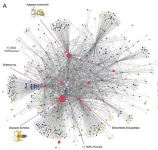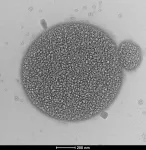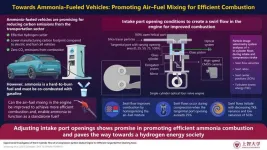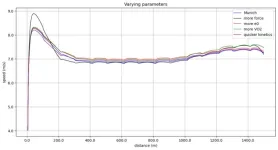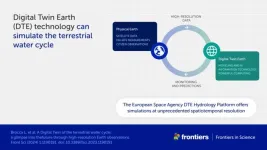(Press-News.org) A theoretical experiment characterized the network architecture of a species-rich ecosystem over 8 months. Predator–prey interaction networks play a key role in structuring ecosystems, but ecological research has often treated such networks as static, despite the broadly accepted understanding of ecosystems as dynamic. Hirokazu Toju and colleagues followed the complex food webs between 50 predatory spider species and 974 prey species, including midges, springtails, mosquitoes, and aphids, for eight months. The studied ecosystem is a warm-temperate grassland located at the Center for Ecological Research at Kyoto University, Japan. In a previous study, spiders were collected by sweeping with an insect net for a few days each month. Then the spiders’ prey was identified by DNA metabarcoding of spiders’ gut contents. The network created from this data shifted between consecutive months from April to November. Some species left, others appeared, and—most impactfully—some predators switched prey. In the current study, the authors use these data to create a framework for identifying which species contribute to the flexibility of the overall network architecture, species which they designate as “network coordinators.” Network coordinators, such as the sit-and-wait predatory spider Oxyopes sertatus and the web-weaving spider Argiope bruennichi, can shift to new relationships in response to biotic or abiotic environmental changes, and thus offer a measure of stability to the network as a whole. Detritivore prey such as nonbiting midges (Chironomus) and springtails (Homidia) also showed high contributions to network flexibility, suggesting that a stable above-ground ecosystem may rely on the stability of the soil ecosystem beneath it. According to the authors, ecology must consider the dynamism of networks if the discipline hopes to understand mechanisms determining community stability—an important question for those who might want to conserve ecosystems as they weather the unprecedented environmental changes of the Anthropocene.
END
Food web flexibility through time
2024-03-05
ELSE PRESS RELEASES FROM THIS DATE:
One way to improve a fusion reaction: Use weaknesses as strengths
2024-03-05
In the Japanese art of Kintsugi, an artist takes the broken shards of a bowl and fuses them back together with gold to make a final product more beautiful than the original.
That idea is inspiring a new approach to managing plasma, the super-hot state of matter, for use as a power source. Scientists are using the imperfections in magnetic fields that confine a reaction to improve and enhance the plasma in an approach outlined in a new paper in the journal Nature Communications.
“This approach allows you to maintain ...
Predicting who will experience aesthetic chills
2024-03-05
Researchers built a model that can predict with 73.5% accuracy when a person will experience aesthetic chills: shivers, goosebumps, or a feeling of cold down the neck or spine elicited by aesthetic stimuli, such as beautiful music or an inspirational speech. Felix Schoeller and colleagues surveyed 2,937 people from Southern California, through an online platform, gathering data on their personalities, demographic backgrounds, and emotional state. The authors then exposed survey respondents to 40 emotion-evoking audiovisual clips sourced from social media, selected because commenters had reported experiencing aesthetic chills while watching and listening. ...
Possible ‘Trojan Horse’ found for treating stubborn bacterial infections
2024-03-05
PULLMAN, Wash. – Bacteria can be tricked into sending death signals to stop the growth of their slimy, protective homes that lead to deadly infections, a new study demonstrates.
The discovery by Washington State University researchers could someday be harnessed as an alternative to antibiotics for treating difficult infections. Reporting in the journal, Biofilm, the researchers used the messengers, which they named death extracellular vesicles (D-EVs), to reduce growth of the bacterial communities by up to 99.99% in laboratory experiments.
“Adding the death extracellular vesicles to ...
AI art and human creativity
2024-03-05
Text-to-image generative AI systems like Midjourney, Stable Diffusion, and DALL-E can produce images based on text prompts that, had they been produced by humans, would plausibly be judged as “creative.” Some artists have argued that these programs are a threat to human creativity. If AI comes to be relied on to produce most new visual works, drawing on what has been done before, creative progress could stagnate. Eric Zhou and Dokyun “DK” Lee investigated the impact of text-to-image AI tools on human creativity, seeking to understand ...
Decoding cryptocurrency regulation in the legibility framework
2024-03-05
Since its introduction, cryptocurrency governance has been one of the most controversial global financial topics. While some countries have established elaborate regulations for cryptocurrencies, many countries are still reluctant to oversee the markets, and some have outright banned them. Most studies suggest that public agencies naturally want to regulate markets and bring them into their purview. However, the significant differences in cryptocurrency regulation over the world call this view into question. Moreover, these differences cannot be explained by the development ...
Ammonia-powered engines: A path to cleaner and more efficient transportation
2024-03-05
While the transportation sector has witnessed a dramatic shift toward electric vehicles (EVs), the idea of using hydrogen as a clean and efficient fuel for transportation has been explored for many decades. These vehicles emit water on combustion, and since they are based on the production of existing engine vehicles, they are expected to have a lower manufacturing carbon footprint than EVs. However, storing and transporting hydrogen requires high pressures and low temperatures, which are energy-intensive processes. To address this, ammonia has ...
Running performance helped by mathematical research
2024-03-05
How to optimise running? A new mathematical model1 has shown, with great precision, the impact that physiological and psychological parameters have on running performance and provides tips for optimised training. The model grew out of research conducted by a French-British team including two CNRS researchers2, the results of which will appear on March 5th 2024 in the journal Frontiers in Sports and Active Living.
This innovative model was developed thanks to extremely precise data3 from the performances of Matthew Hudson-Smith (400m), Femke Bol (400m), and ...
New ‘digital twin’ Earth technology could help predict water-based natural disasters before they strike
2024-03-05
The water cycle looks simple in theory — but human impacts, climate change, and complicated geography mean that in practice, floods and droughts remain hard to predict. To model water on Earth, you need incredibly high-resolution data across an immense expanse, and you need modeling sophisticated enough to account for everything from snowcaps on mountains to soil moisture in valleys. Now, scientists funded by the European Space Agency have made a tremendous step forward by building the most detailed models created to date.
“Simulating ...
Sweetened drinks linked to atrial fibrillation risk
2024-03-05
Research Highlights:
An analysis of health data in the UK Biobank found a 20% higher risk of irregular heart rhythm, known as atrial fibrillation, among people who said they drank two liters or more per week (about 67 ounces) of artificially sweetened drinks. The risk was 10% higher among people who said they drank similar amounts of sugar-sweetened beverages.
Drinking one liter (about 34 ounces) or less of pure juice per week, such as 100% orange or vegetable juice, was associated with an 8% lower risk of atrial fibrillation.
The observational study could not confirm that sweetened drinks cause irregular heart rhythms.
Embargoed ...
Hazardous heat and humidity is widespread in US jails and prisons, and climate change is worsening conditions
2024-03-05
An estimated 1.8 million incarcerated people in the United States have been recently exposed to a dangerous combination of heat and humidity, and on average experience 100 days of these conditions each year—many of them in the 44 states that do not provide universal air conditioning to inmates. Tracking with climate change, in recent decades, the number of dangerous humid heat days in carceral facilities has increased, with those in the south experiencing the most rapid warming.
The findings by researchers at Columbia University Mailman School of Public Health, Montana State University, ...
